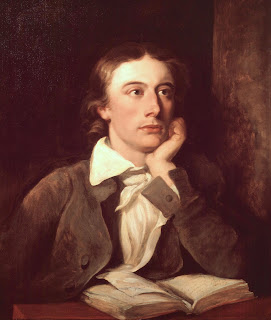Sea Fever 1) Who wrote the poem ‘Sea Fever’? Ans:- John Masefield wrote the poem ’Sea Fever’. 2) What was the favourite place of the poet? Ans:- To see the sea was the favourite place of the poet. 3) What do you mean by steer? Ans:- Steer means to control the direction of movement. 4) What was the colour of mist on the sea’s face? Ans:- The colour of the mist was grey. 5) What thing did not the poet deny? Ans:- The poet can not deny the call of running tide. 6) Write the name of Sea-bird? Ans:- Sea-gull is the name of a sea-bird. 7) Who wants to live a gypsy life? Ans:- The poet wants to become a gypsy life. 8) Write the name of the sea-animal? Ans:- Whale, a name of the sea-animal. 9) What do you mean by whetted knife? Ans:- Whetted knife means sharpened knife. 10) What kind of day does the poet prefer for siling? Ans:- The poet prefers va...
Discuss Keats's treatment of life and art in "Ode to a Grecian Urn".
Answer>
Answer>
The romantic of romantics , the worshipper of beauty,the embodiment of sensuousness,the escapist by nature and hellenistic John Keats in Ode to a Grecian Urn very aptly and masterfully blands the the world of life and the world of art. Most of his poem include the conflict between art and life;ideal and real;the temporal and eternal;the fluid and the flux . Among all his odes ,Ode to a Grecian Urn is surely the purest gem and a poem that adds a colourful feathers to the crown of romantic hero Keats. Keats imagines the identify of the people depicted on the vase and ponders if they are enviable because they are forever young and in love . He contrasts this idea with cold ,stagant ,nature of being frozen in the created scene.
Keats's poem is an Ode,a lyrical style of poetry often written in celebration of a person ,place , thing and an idea. The poet has deeply analysised with Grecian Urn on which a scene of love and revelry takes place.Because the object about which he write , is a work of art , Keats's poem takes on the ekphrasis style ; meaning a poem vividly describing a scene on work of art . By using art as a catalyst to contemplate life,Keats already contrasts the two.
Keats guesses are the feeling of the couple,thus moving beyond a mere ekphrastic description of the scene . He includes his own thoughts on the nature of art and life. By involving himself in the contemplation,his experience of observing the Urn becomes an important aspect of the poem . Keats also describes a scene not portrayed on the urn. The perpetual emptiness of the village from which the urn's charecters come with this further imagining. He invite the reader to join in his speculation. He therefore involves himself and his readers in comparing art and life in the poem.
On the urn ,the immortality and the beauty have been captured by the artist whereas contradictory, life is ruthless ,humans are immortal,bound to face death and disease . For an artist ,truth is what the piece of art bears, an artist create. Creates his own replica,his own reality,on the urn ,all that is captured is beautiful and good,and for the artist all that is true is the seemingly goodness , beauty and immortality and that is what art is . To him life is just either a cruel monster :
"Beauty is truth and truth is beauty".
The contrast Keats creates between art and life in " Ode to a Grecian Urn"
is precisely this -that art is better than life. In fact Keats proves this when says : " Heard melodies are sweet,but those unheard/Are sweeter". Why is art better than life? Art ,as in the from of urn ,can capture life at its best and keep it there.
"Beauty is truth and truth is beauty".
The contrast Keats creates between art and life in " Ode to a Grecian Urn"
is precisely this -that art is better than life. In fact Keats proves this when says : " Heard melodies are sweet,but those unheard/Are sweeter". Why is art better than life? Art ,as in the from of urn ,can capture life at its best and keep it there.
"Bold lover naver,naver canst thou kiss,/Though winning near the goal- .../ Forever wilt thou love ,and she be fair".
Although ingeniously left unstated here ,the contrast between art and life is vivid . This love can literally never kiss his love. In life they could kiss? yes, but that is not real goal.Keats ever uses the world winning to prove that art is the true capturer of beauty here would eventually fade as well.
Although ingeniously left unstated here ,the contrast between art and life is vivid . This love can literally never kiss his love. In life they could kiss? yes, but that is not real goal.Keats ever uses the world winning to prove that art is the true capturer of beauty here would eventually fade as well.
Near the end of the poem, Keats even borders on jealousy of the urn that will stand steadfast in beauty as the rest of the earth may waste away. Keats even goes so far as to call it . "Cold pastoral ! when old age shall this generation waste /Thou shalt remain". Of course,the contrast between art and life is finalized in the final concluding lines of the poem as well: "Beauty is truth and truth is beauty,that is all/ Ye known on earth ,and all ye need to know." Truth ,then can precisely be found upon the urn . Therefore art presents for us a utopia for the world to reside in its own way.and the treatment of art and life is appropriated.






Comments
Post a Comment